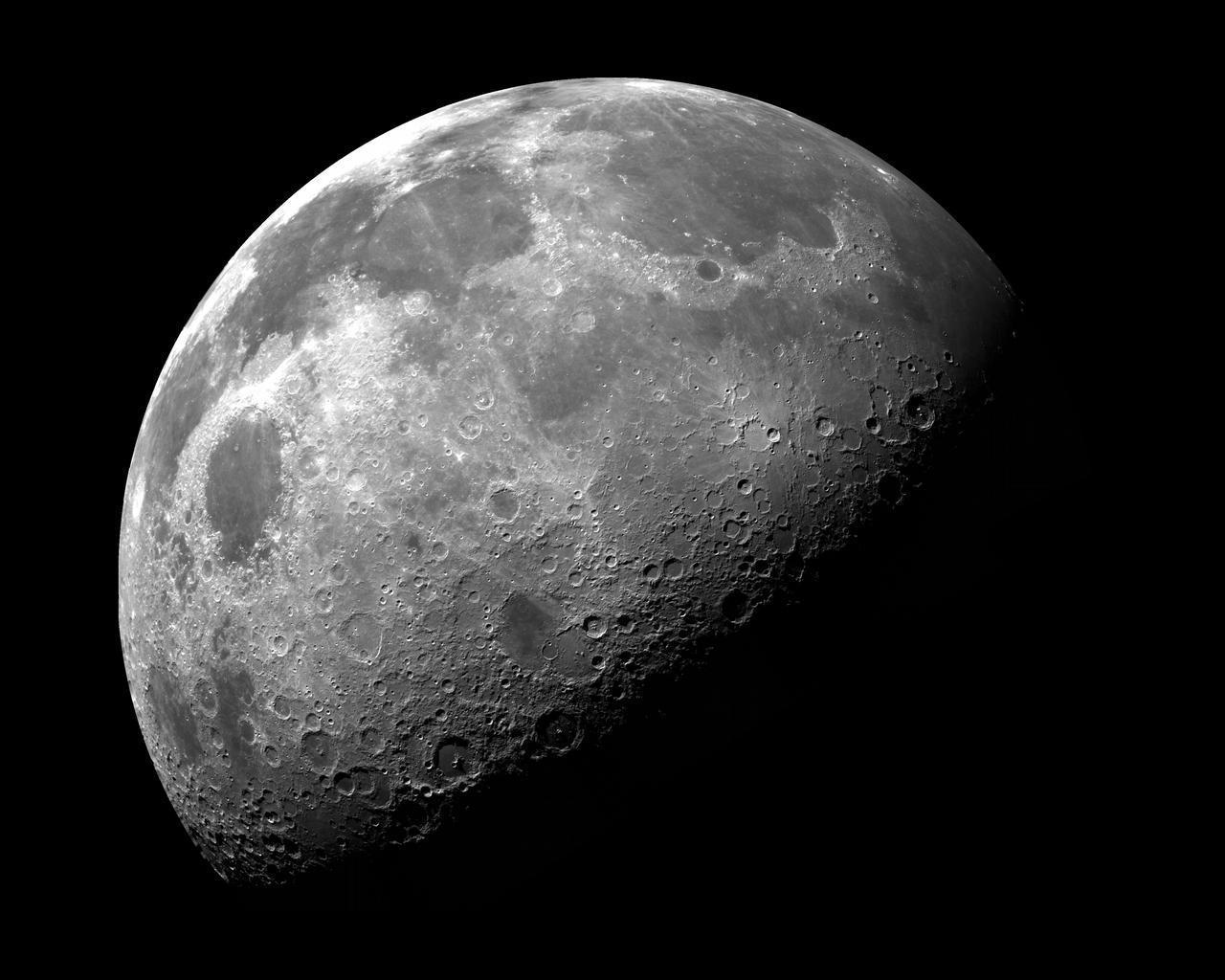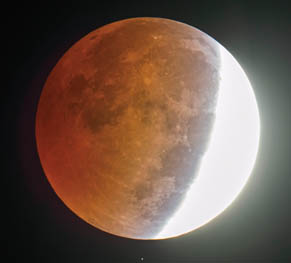
A globe is a three-dimensional, spherical, scale model of Earth (terrestrial globe or geographical globe) or other celestial body such as a planet or moon. While models can be made of objects with arbitrary or irregular shapes, the term globe is used only for models of objects that are approximately spherical. The word “globe” comes from the Latin word globus, meaning round mass or sphere. Some terrestrial globes include relief to show mountains and other features on the Earth’s surface.
There are also globes, called celestial globes or astronomical globes, which are spherical representations of the celestial sphere, showing the apparent positions of the stars and constellations in the sky.
Below are 10 proves that the earth is round and not flat.
1. The
Moon

Now that humanity knows quite positively that the Moon is not a
piece of cheese or a playful god, the phenomena that accompany it (from its
monthly cycles to lunar eclipses) are well-explained. It was quite a mystery to
the ancient Greeks, though, and in their quest for knowledge, they came up with
a few insightful observations that helped humanity figure out the shape of our
planet.
Aristotle (who made quite a lot of observations about the
spherical nature of the Earth) noticed that during lunar eclipses (when the
Earth’s orbit places it directly between the Sun and the Moon, creating a
shadow in the process), the shadow on the Moon’s surface is round. This shadow
is the Earth’s, and it’s a great clue on the spherical shape of the Earth.
LUNAR ECLIPSE

A sequential
view of the lunar eclipse that occurred on April 15, 2014. You can see Earth's
shadow crossing the face of the Moon, and the shadow's shape is curved because
Earth is spherical.
Javier Sánchez
Since
the earth is rotating (see the “Foucault Pendulum”
experiment for a definite proof, if you are doubtful), the consistent
oval-shadow it produces in each and every lunar eclipse proves that the earth
is not only round but spherical – absolutely, utterly, beyond a shadow of a
doubt not flat.
2. Ships and the Horizon

If
you’ve been next to a port lately, or just strolled down a beach and stared off
vacantly into the horizon, you might have, perhaps, noticed a very interesting
phenomenon: approaching ships do not just “appear” out of the horizon (like
they should have if the world was flat), but rather emerge from beneath the
sea.
But –
you say – ships do not submerge and rise up again as they approach our view
(except in “Pirates of the Caribbean”, but we are hereby assuming that was a
fictitious movie). The reason ships appear as if they “emerge from the waves”
is because the world is not flat: it’s round.
ANT ON AN ORANGE
What you
would see if you watched an ant crawling toward you over a curved surface.
Moriel Schottlender
Imagine
an ant walking along the surface of an orange, into your field of view. If you
look at the orange “head on”, you will see the ant’s body slowly rising up from
the “horizon”, because of the curvature of the Orange. If you would do that
experiment with a long road, the effect would have changed: The ant would have
slowly ‘materialized’ into view, depending on how sharp your vision is.
3. Varying Star Constellations
This
observation was originally made by Aristotle (384-322 BCE), who declared the
Earth was round judging from the different constellations one sees while moving
away from the equator.
STARGAZING ON A ROUND EARTH
Stargazing
On A Round Earth
Moriel Schottlender
After
returning from a trip to Egypt, Aristotle noted that “there are stars seen in
Egypt and…Cyprus which are not seen in the northerly regions.” This phenomenon
can only be explained if humans were viewing the stars from a round surface.
Aristotle continued and claimed that the sphere of the Earth is “of no great
size, for otherwise the effect of so slight a change of place would not be
quickly apparent.” (De caelo, 298a2-10)
The
farther you go from the equator, the farther the ‘known’ constellations go
towards the horizon, and are replaced by different stars. This would not have
happened if the world was flat:
STARGAZING ON A FLAT EARTH
Stargazing
On A Flat Earth
Moriel Schottlender
4. Shadows and Sticks
If
you stick a stick in the (sticky) ground, it will produce a shadow. The shadow
moves as time passes (which is the principle for ancient Shadow
Clocks). If the world had been flat, then two sticks in different
locations would produce the same shadow:
STICK SHADOWS ON A FLAT EARTH
Imagine
the Sun's rays (represented by yellow lines) hitting two sticks (white lines)
some distance apart. If the Earth were flat, the resulting shadows would be the
same length, no matter how far apart you place the sticks.
Moriel Schottlender
But
they don’t. This is because the earth is round, and not flat:
STICK SHADOWS ON A ROUND EARTH
Because
the Earth is round, sticks placed at distant locations will throw shadows of
different lengths.
Moriel Schottlender
Eratosthenes
(276-194 BCE) used this principle to calculate the circumference of the Earth
quite accurately. To see this demonstrated, refer to my
experiment videoabout Eratosthenes and the circumference of the
Earth.
5. Seeing Farther from Higher
Standing
in a flat plateau, you look ahead of you towards the horizon. You strain your
eyes, then take out your favorite binoculars and stare through them, as far as
your eyes (with the help of the binocular lenses) can see.
Then,
you climb up the closest tree – the higher the better, just be careful not to
drop those binoculars and break their lenses. You then look again, strain your
eyes, stare through the binoculars out to the horizon.
The
higher up you are the farther you will see. Usually, we tend to relate this to
Earthly obstacles, like the fact we have houses or other trees obstructing our
vision on the ground, and climbing upwards we have a clear view, but that’s not
the true reason. Even if you would have a completely clear plateau with no
obstacles between you and the horizon, you would see much farther from greater
height than you would on the ground.
This
phenomenon is caused by the curvature of the Earth as well, and would not
happen if the Earth was flat:
POINT OF VIEW ON A FLAT EARTH
Point Of
View On A Flat Earth
Moriel Schottlender
POINT OF VIEW ON A ROUND EARTH
Point Of
View On A Round Earth
Moriel Schottlender
6. Ride a Plane
If
you’ve ever taken a trip out of the country, specifically long-destination
trips, you could notice two interesting facts about planes and the Earth:
1. Planes
can travel in a relatively straight line a very long time and not fall off any
edges. They can also circle the Earth without stopping.
2. If
you look out the window on a trans-Atlantic flight, you can, most of the times,
see the curvature of the earth in the horizon. The best view of the curvature
used to be on the Concorde,
but that plane’s long gone. I can’t wait seeing the pictures from the new plane
by “Virgin Galactic” – the horizon should look absolutely curved, as it
actually is from a distance.
7. Look at Other Planets

The
Earth is different from other planets, that much is true. After all, we have
life, and we haven’t found any other planets with life (yet). However, there
are certain characteristics all planets have, and it will be quite logical to
assume that if all planets behave a certain way, or show certain
characteristics – specifically if those planets are in different places or were
created under different circumstances – our planet is the same.
In
other words: If so many planets that were created in different locations and
under different circumstances show the same property, it’s likely that our own
planet has the same property as well. All of our observations show planets are
spherical (and since we know how they’re created, it’s also obvious why they
are taking this shape). Unless we have a very good reason to think otherwise
(which we don’t), our planet is very likely the same.
In
1610, Galileo Galilei observed the
moons of Jupiter rotating around it. He described them as small
planets orbiting a larger planet – a description (and observation) that was
very difficult for the church to accept as it challenged a geocentric model
where everything was supposed to revolve around the Earth. This observation
also showed that the planets (Jupiter, Neptune, and later Venus was observed
too) are all spherical, and all orbit the sun.
A
flat planet (ours or any other planet) would be such an incredible observation
that it would pretty much go against everything we know about how planets form
and behave. It would not only change everything we know about planet formation,
but also about star formation (as our sun would have to behave quite
differently to accustom a “flat earth” theory), what we know of speeds and
movements in space (like planets' orbits, and the effects of gravity, etc). In
short, we don’t just suspect that our planet is spherical. We know it.
8. The Existence of Timezones
The
time in New York, at the moment these words are written, is 12:00pm. The sun is
in the middle of the sky (though it’s hard to see with the current cloud
coverage). In Beijing, it’s 12:00am, midnight, and the sun is nowhere to be
found. In Adelaide, Australia, it is 1:30am. More than 13 hours ahead. There,
the sunset is long gone – so much so, that it’s soon going to rise up again in
the beginning of a new day.
TIME ZONES
We have
time zones because when the Sun is illuminating one side of the spherical
Earth, the other side is dark.
Moriel Schottlender
This
can only be explained if the world is round, and rotating around its own axis.
At a certain point when the sun is shining on one part of the Earth, the
opposite side is dark, and vise versa. That allows for time differences and
timezones, specifically ones that are larger than 12 hours.
Another
point concerning timezones, the sun and flat/spherical Earth: If the sun was a
“spotlight” (very directionally located so that light only shines on a specific
location) and the world was flat, we would have seen the sun even if it didn’t
shine on top of us (as you can see in the drawing below). The same way you can
see the light coming out of a spotlight on a stage in the theater, even though
you – the crowd – are in the dark. The only way to create two distinctly
separate timezones, where there is complete darkness in one while there’s light
in the other, is if the world is spherical.
DEBUNKING THE "SUN AS SPOTLIGHT" THEORY
Debunking
The "Sun As Spotlight" Theory
Moriel Schottlender
9. The Center of Gravity
There’s
an interesting fact about mass: it attracts things to it. The force of
attraction (gravity) between two objects depends on their mass and the distance
between them. Simply said, gravity will pull toward the center of mass of the
objects. To find the center of mass, you have to examine the object.
A SPHERE'S CENTER OF MASS
A
Sphere's Center Of Mass
Moriel Schottlender
Consider
a sphere. Since
a sphere has a consistent shape, no matter where on it you stand, you have
exactly the same amount of sphere under you. (Imagine an ant walking around on
a crystal ball. From the insect's point of view, the only indication of
movement would be the fact the ant is moving its feet. The shape of the surface
would not change at all.) A sphere's center of mass is in the center of the
sphere, which means gravity will pull anything on the surface toward the center
of the sphere (straight down) no matter where it's located.
Consider
a flat plane. The
center of mass of a flat plane is in its center (more or less – if you want to
be more accurate, feel free to do the entire integration process), so the force
of gravity will pull anything on the surface toward the middle of the plane.
That means that if you stand on the edge of the plane, gravity will be pulling
you toward the middle, not straight down like you usually experience.
A PLANE'S CENTER OF MASS
A plane's
center of mass is in the middle—which means that gravity should pull objects toward
the center of the plane.
Moriel Schottlender
I am
quite positive that, even for Australians, an apple falls downwards, not
sideways. But if you have your doubts, I urge you to try dropping something –
just make sure it’s nothing that can break or hurt you.
Further
reading about the center of mass and about distribution of mass can be found here. And if
you are brave enough to handle some equations (not involving integration), you
can learn some more about Newton’s Law of Universal Gravitationhere.
10. Images from Space


In
the past 60 years of space exploration, we’ve launched satellites, probes, and
people to space. Some of them got back, some of them still float through the
solar system (and almost beyond it) and transmit amazing images over to our
receivers on Earth. And in all of the photos, the Earth is (wait for it)
spherical. The curvature of the Earth is also visible in the many, many, many, many photos snapped by astronauts on the
International Space Station. You can see a recent example from ISS Commander Scott
Kelly's Instagram right here:
You
know what they say—a picture is worth a thousand diss
tracks.
Moriel
Schottlender is a software engineer at Wikimedia Foundation. This article was
originally posted on her Smarter
Than That blog
in 2008.
Be_Inspired!!!


No comments:
Post a Comment